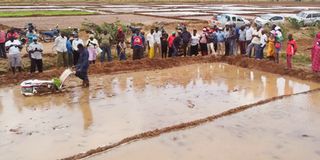Once dormant Hola scheme springs back to life with rice farming

Farmers follow an ongoing demonstration of rice planting at the Hola Irrigation Scheme in Tana River County.
One of Kenya’s oldest irrigation and settlement schemes in Hola, Tana River County, is springing back to life thanks to an influx of farmers from Mwea.
The newcomers and a group of local farmers now carry the hopes of feeding Kenya’s population with a shift from rain-fed agriculture to irrigation-based farming to improve food security.
The revival has also been boosted by the introduction of the new Komboka rice variety, which is suitable for the Tana River climate, with locals ditching maize farming for rice.
The National Irrigation Authority (NIA) has also begun opening up fields for rice propagation.
More than 100 farmers from the Mwea Irrigation Scheme are leasing Hola farms as a result of reduced acreage of farms in Kirinyaga.
Mrs Emily Wachira is among the many farmers who have migrated from Mwea Bura to embark on large-scale production of rice in Tana River.
"There is more room for farming here compared to Mwea and most encouraging is the market availability here unlike where I have come from," said Mrs Wachira.
This will be the first time the Tana River-based irrigation scheme will incorporate large-scale production of the Komboka rice variety.
Hola Irrigation Scheme manager James Kirigia said NIA intends to put more than 2,000 acres under production, with more than 100 farmers expected to partake in the venture.
"This variety has proved to be a gold mine in Hola and farmers are shifting from maize farming. A majority of those flocking our farm at the moment seeking to grow rice are the Mwea rice migrants," he said.
Mr Kirigai said the irrigation authority has tested the grain variety on the farm and it has proved to be productive and will be given to farmers.
At least 150 farmers are practising production, with 600 acres of the crop planted last September being harvested.
"The production has picked up in Hola, and the coming of the farmers from Bura and Mwea is inspiring healthy competition, hence bolstering production," he said.
NIA hopes to have 1,500 acres of the Hola farm under rice production, where more than 300 migrant farmers have applied for space for production.
The influx of migrant farmers in the Hola farm is expected to rival production in the Bura scheme, which has more than 2,000 acres under production.
Farmers are upbeat about rice production as the National Cereals and Produce Board seeks more from the Tana River-based farms and hence providing a ready market for their harvest.
Farmers said NCPB buys their produce at Sh45 per kilogram, a fortune they say that inspires more farmers to venture into rice farming.
"If this is how life would be, then farmers in Tana River would be very rich. We feel like the irrigation schemes in the county are bouncing back and rice production is the real deal," said farmer Angela Kuria.
Whereas a larger percentage of the farmers seek to propagate rice for domestic consumption, some have expressed interest in large-scale production of the grain.
The Hola (Tana) Irrigation and Settlement Scheme was started in 1953 by the colonial government as a holding camp for detainee labour.
It occupies about 4,800 hectares of land.





